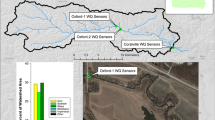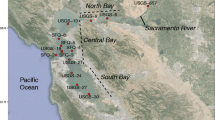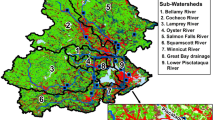Abstract
Nitrate and water quality parameters (temperature, salinity, dissolved oxygen, turbidity, and depth) were measured continuously with in situ NO3 analyzers and water quality sondes at two sites in Elkhorn Slough in Central California. The Main Channel site near the mouth of Elkhorn Slough was sampled from February to September 2001. Azevedo Pond, a shallow tidal pond bordering agricultural fields further inland, was sampled from December 1999 to July 2001. Nitrate concentrations were recorded hourly while salinity, temperature, depth, oxygen, and turbidity were recorded every 30 min. Nitrate concentrations at the Main Channel site ranged from 5 to 65 μM. The propagation of an internal wave carrying water from ≈100 m depth up the Monterey Submarine Canyon and into the lower section of Elkhorn Slough on every rising tide was a major source of nitrate, accounting for 80–90% of the nitrogen load during the dry summer period. Nitrate concentrations in Azevedo Pond ranged from 0–20 μM during the dry summer months. Nitrate in Azevedo Pond increased to over 450 μM during a heavy winter precipitation event, and interannual variability driven by differences in precipitation was observed. At both sites, tidal cycling was the dominant forcing, often changing nitrate concentrations by 5-fold or more within a few hours. Water volume flux estimates were combined with observed nitrate concentrations to obtain nitrate fluxes. Nitrate flux calculations indicated a loss of 4 mmol NO3 m−2 d−1 for the entire Elkhorn Slough and 1 mmol NO3 m−2 d−1 at Azevedo Pond. These results suggested that the waters of Elkhorn Slough were not a major source of nitrate to Monterey Bay but actually a nitrate sink during the dry season. The limited winter data at the Main Channel site suggest that nitrate was exported from Elkhorn Slough during the wet season. Export of ammonium or dissolved organic nitrogen, which we did not monitor, may balance some or all of the NO3 flux.
Similar content being viewed by others
Literature Cited
Beck, N. G. andK. W. Bruland. 2000. Diel biogeochemical cycling in a hyperventilating shallow estuarine environment.Estuaries 23:177–187.
Beck, N. G., A. T. Fisher, andK. W. Bruland. 2001. Modeling water, heat, and oxygen budgets in a tidally dominated estuarine pond.Marine Ecology Progress Series 217:43–58.
Boynton, W. R., J. H. Garber, R. Summers, andW. M. Kemp. 1995. Inputs, transformations, and transport of nitrogen and phosphorus in Chesapeake Bay and selected tributaries.Estuaries 18:285–314.
Breaker, L. C. andW. W. Broenkow. 1994. The Circulation of Monterey Bay and Related Processes.Oceanography and Marine Biology Annual Review 32:1–64.
Brewer, P. G. andJ. P. Riley. 1965. The automatic determination of nitrate in seawater.Deep-Sea Research 12:765–772.
Caffrey, J. M. 2002. Biogeochemical Cycling, p. 211–233.In J. M. Caffrey, M. Brown, B. Tyler, M. Silberstein (eds.), Changes in a California Estuary: An Ecosystem Profile of Elkhorn Slough. Chapter 12. Elkhorn Slough Foundation. Moss Landing, California.
Caffrey, J. M. 2003. Production, Respiration and Net Ecosystem Metabolism in U.S. Estuaries.Environmental Monitoring and Assessment 81:207–219.
Caffrey, J. M. andW. Broenkow. 2002. Hydrology, p. 31–46.In J. M. Caffrey, M. Brown, B. Tyler, M. Silberstein (eds.), Changes in a California Estuary: An Ecosystem Profile of Elkhorn Slough. Chapter 4. Elkhorn Slough Foundation. Moss Landing, California.
Caffrey, J. M. andJ. W. Day Jr. 1986. Control of the variability of nutrients and suspended sediments in a Gulf Coast estuary by climatic forcing and spring discharge of the Atchafalaya River.Estuaries 9:295–300.
Caffrey, J. M., N. E. Harrington, I. Solem, andB. B. Ward. 2003. Biogeochemical Processes in a Small California estuary: 2. Nitrification Activity, Community Structure and Role in Nitrogen Budgets.Marine Ecology Progress Series 248:27–40.
Caffrey, J. M., N. Harrington, andB. Ward. 2002. Biogeochemical processes in a small California estuary: 1. Benthic flux and pore water constituents reflect high nutrient fresh-water inputs.Marine Ecology Progress Series 233:39–53.
Duke Energy. 2000. Final report: Evaluation of proposed discharge system with respect to the thermal plan.In Moss Landing power plant modernization project. Duke Energy Moss Landing LLC, Moss Landing, California.
Glasgow, H. B. J. andJ. M. Burkholder. 2000. Water quality trends and management implications from a five-year study of a eutrophic estuary.Ecological Applications 10:1024–1046.
Heard, A. J. 1992. A Kinematic Model of Baroclinic Tidal Currents at the Head of Monterey Submarine Canyon. M.S. Thesis, San Jose State University, San Jose, California.
Hubertz, E. D. andL. B. Cahoon. 1999. Short-term variability of water quality parameters in two shallow estuaries of North Carolina.Estuaries 22:814–823.
Jickells, T. 1998. Nutrient biogeochemistry of the coastal zone.Science 281:217–222.
Johnson, K. S. 2003. State of Technology in the Development and Application of Nutrient Sensors. Alliance for Coastal Technology Workshop, http://www.actonline.ws/Download/ Nutrient_Sensor_Report.pdf)
Kremer, J. N., W. M. Kemp, A. E. Giblin, I. Valiela, S. P. Seitzinger, andE. E. Hoffman. 2000. Linking biogeochemical processes to higher trophic levels, p. 299–341In J. Hobbie (ed.), Estuarine science: A synthetic approach to research and practice. Island Press. Washington, D.C.
Los Huertos, M., L. E. Gentry, andC. Shennan. 2001. Land use and stream nitrogen concentrations in agricultural watersheds along the Central Coast of California.The Scientific World Journal 1:615–622.
Malzone, C. M. 1999. Tidal scour and its relation to erosion and sediment transport in Elkhorn Slough. M.S. Thesis, San Jose State University, San Jose, California.
National Research Council (NRC). 2000. Clean Coastal Waters: Understanding and reducing the effects of nutrient pollution. National Academy Press, Washington, D.C.
Nixon, S. W. 1995. Coastal marine eutrophication: a definition, social causes, and future concerns.Ophelia 41:199–219.
Nixon, S. W., S. L. Granger, andB. L. Nowicki. 1995. An assessment of the annual mass balance of carbon, nitrogen, and phosphorus in Narragansett Bay.Biogeochemistry 31:15–61.
Odum, H. T. andC. M. Hoskins. 1958. Comparative studies on the metabolism of marine waters. Publications of the Institute of Marine Science University of Texas, 5:16–46.
Pennington, J. T. andF. P. Chavez. 2000. Seasonal fluctuations of temperature, salinity, nitrate, chlorophyll, and primary production at station H3/M1 over 1989–1996 in Monterey Bay, California.Deep-Sea Research 47:947–973.
Petruncio, E. T., L. K. Rosenfeld, andJ. D. Paduan. 1998. Observations of the internal tide in Monterey Canyon.Journal of Physical Oceanography 28:1873–1903.
Rabalais, N. N., R. E. Turner, D. Justic, Q. Dortch, W. J. Wiseman, andB. K. Sen Gupta. 1996. Nutrient changes in the Mississippi River and system responses on the adjacent continental shelf.Estuaries 19:386–407.
Risgaard-Petersen, N., T. Dalsgaard, S. Rysgaard, P. B. Christensen, J. Borum, K. McGlathery, andL. P. Nielsen. 1998. Nitrogen balance of a temperate eelgrassZostera marina bed.Marine Ecology Progress Series 174:281–291.
Rosenfeld, L. K., J. D. Paduan, E. T. Petruncio, and J. E. Goncalves. Internal Tide in a Submarine Canyon. http://www.oc.nps.mil/~radlab/LIWI/aha99rosenfeld.pdf.
Sakamoto, C. M., G. E. Friederich, and L. A. Codispoti. 1990. MBARI Procedures for Automated Nutrient Analyses Using a Modified Alpkem Series 300 Rapid Flow Analyzer. MBARI Technical Report No. 90-2. Moss Landing, California.
Sitzinger, S. P. 1988. Denitrification in freshwater and coastal marine ecosystems: Ecological and geochemical significance.Limnology and Oceanography 33:702–724.
Seitzinger, S. P. 2000. Scaling Up: Site specific measurements to Global-scale estimates of denitrification, p. 211–240.In: J. E. Hobbes (ed.), Estuarine science: A synthetic approach to research and practice. Island Press. Washington, D.C.
Shea, R. E. andW. W. Broenkow. 1982. The Role of Internal Tides in the Nutrient Enrichment of Monterey Bay, California.Estuarine and Coastal Shelf Science 15:57–66.
Shumway, R. H. andD. S. Stoffer. 2000. Time Series Analysis and its Applications (Springer Texts in Statistics). Springer-Verlag, New York, New York.
Smith, R. E. 1973. The hydrography of Elkhorn Slough, a shallow California Coastal Embayment. Technical Publication 73-2, Moss Landing Marine Laboratories, Moss Landing, California.
Smith, C. J., R. D. DeLaune, andW. H. Patrick. 1985. Fate of Riverine Nitrate Entering an estuary: 1. Denitrification and Nitrogen Burial.Estuaries 8:15–21.
Trimmer, M., D. B. Nedwell, D. B. Sivyer, andS. J. Malcolm. 2000. Seasonal organic mineralization and denitrification in intertidal sediments and their relationship to the abundance of Enteromorpha sp. and Ulva sp.Marine Ecology Progress Series 203:67–80.
Varney, M. S. 2000. Chemical Sensors in Oceanography. Ocean Science and Technology, 1. Gordon and Breach Science Publishers, Amsterdam, The Netherlands.
Vitousek, P. M., J. D. Aber, R. W. Howarth, G. E. Likens, P. A. Matson, D. W. Schindler, W. H. Schlesinger, andD. G. Tilman. 1997. Human alteration of the global nitrogen cycle: Sources and consequences.Ecological Applications 7:737–750.
Weers, D. A. andK. S. Johnson. 1996. Solenoid pumps for flow injection analysis.Analytical Chemistry 68:2717–2719.
Wong, C. R. 1989. Observations of tides and tidal currents in Elkhorn Slough. M.S. Thesis, San Jose State University, San Jose, California.
Author information
Authors and Affiliations
Corresponding author
Rights and permissions
About this article
Cite this article
Chapin, T.P., Caffrey, J.M., Jannasch, H.W. et al. Nitrate sources and sinks in Elkhorn Slough, California: Results from long-term continuous in situ nitrate analyzers. Estuaries 27, 882–894 (2004). https://doi.org/10.1007/BF02912049
Received:
Revised:
Accepted:
Issue Date:
DOI: https://doi.org/10.1007/BF02912049




